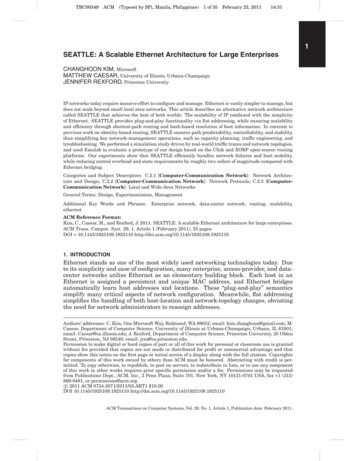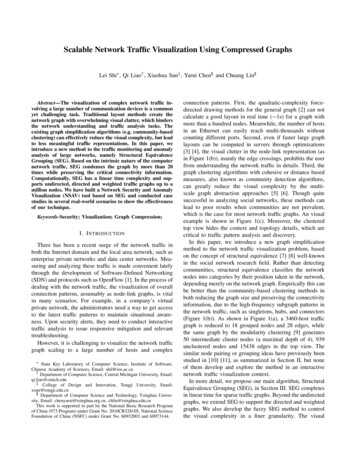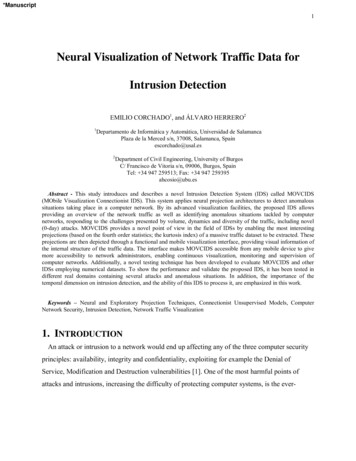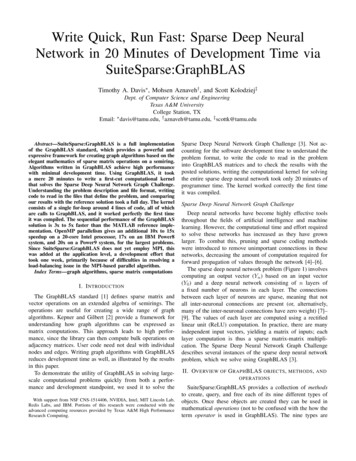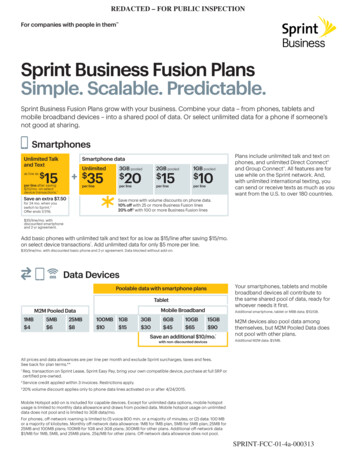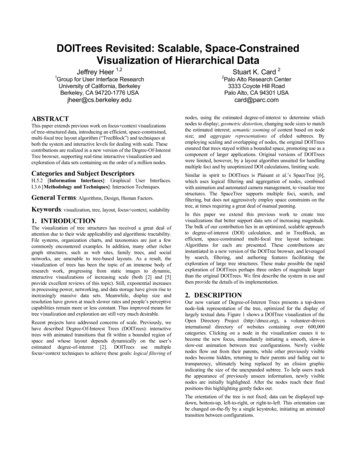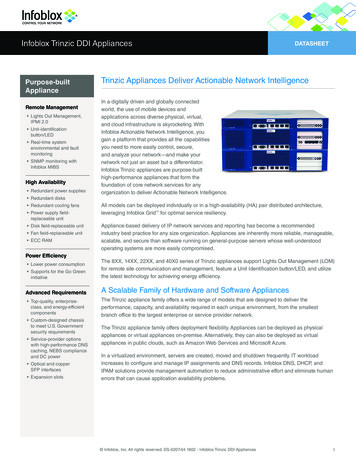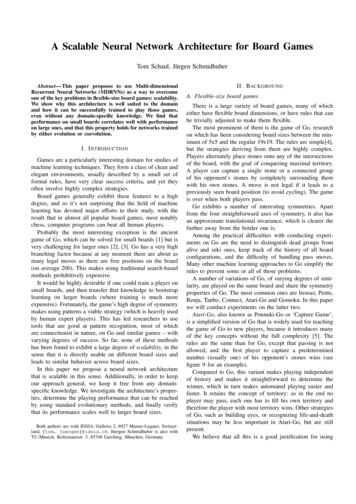
Transcription
A Scalable Neural Network Architecture for Board GamesTom Schaul, Jürgen SchmidhuberAbstract— This paper proposes to use Multi-dimensionalRecurrent Neural Networks (MDRNNs) as a way to overcomeone of the key problems in flexible-size board games: scalability.We show why this architecture is well suited to the domainand how it can be successfully trained to play those games,even without any domain-specific knowledge. We find thatperformance on small boards correlates well with performanceon large ones, and that this property holds for networks trainedby either evolution or coevolution.I. I NTRODUCTIONGames are a particularly interesting domain for studies ofmachine learning techniques. They form a class of clean andelegant environments, usually described by a small set offormal rules, have very clear success criteria, and yet theyoften involve highly complex strategies.Board games generally exhibit these features to a highdegree, and so it’s not surprising that the field of machinelearning has devoted major efforts to their study, with theresult that in almost all popular board games, most notablychess, computer programs can beat all human players.Probably the most interesting exception is the ancientgame of Go, which can be solved for small boards [1] but isvery challenging for larger ones [2], [3]. Go has a very highbranching factor because at any moment there are about asmany legal moves as there are free positions on the board(on average 200). This makes using traditional search-basedmethods prohibitively expensive.It would be highly desirable if one could train a player onsmall boards, and then transfer that knowledge to bootstraplearning on larger boards (where training is much moreexpensive). Fortunately, the game’s high degree of symmetrymakes using patterns a viable strategy (which is heavily usedby human expert players). This has led researchers to usetools that are good at pattern recognition, most of whichare connectionist in nature, on Go and similar games – withvarying degrees of success. So far, none of these methodshas been found to exhibit a large degree of scalability, in thesense that it is directly usable on different board sizes andleads to similar behavior across board sizes.In this paper we propose a neural network architecturethat is scalable in this sense. Additionally, in order to keepour approach general, we keep it free from any domainspecific knowledge. We investigate the architecture’s properties, determine the playing performance that can be reachedby using standard evolutionary methods, and finally verifythat its performance scales well to larger board sizes.Both authors are with IDSIA, Galleria 2, 6927 Manno-Lugano, Switzerland, {tom, juergen}@idsia.ch. Jüergen Schmidhuber is also withTU-Munich, Boltzmannstr. 3, 85748 Garching, München, GermanyII. BACKGROUNDA. Flexible-size board gamesThere is a large variety of board games, many of whicheither have flexible board dimensions, or have rules that canbe trivially adjusted to make them flexible.The most prominent of them is the game of Go, researchon which has been considering board sizes between the minimum of 5x5 and the regular 19x19. The rules are simple[4],but the strategies deriving from them are highly complex.Players alternately place stones onto any of the intersectionsof the board, with the goal of conquering maximal territory.A player can capture a single stone or a connected groupof his opponent’s stones by completely surrounding themwith his own stones. A move is not legal if it leads to apreviously seen board position (to avoid cycling). The gameis over when both players pass.Go exhibits a number of interesting symmetries. Apartfrom the four straightforward axes of symmetry, it also hasan approximate translational invariance, which is clearer thefurther away from the border one is.Among the practical difficulties with conducting experiments on Go are the need to distinguish dead groups fromalive and seki ones, keep track of the history of all boardconfigurations, and the difficulty of handling pass moves.Many other machine learning approaches to Go simplify therules to prevent some or all of those problems.A number of variations of Go, of varying degrees of similarity, are played on the same board and share the symmetryproperties of Go. The most common ones are Irensei, Pente,Renju, Tanbo, Connect, Atari-Go and Gomoku. In this paperwe will conduct experiments on the latter two.Atari-Go, also known as Ponnuki-Go or ‘Capture Game’,is a simplified version of Go that is widely used for teachingthe game of Go to new players, because it introduces manyof the key concepts without the full complexity [5]. Therules are the same than for Go, except that passing is notallowed, and the first player to capture a predeterminednumber (usually one) of his opponent’s stones wins (seefigure 9 for an example).Compared to Go, this variant makes playing independentof history and makes it straightforward to determine thewinner, which in turn makes automated playing easier andfaster. It retains the concept of territory: as in the end noplayer may pass, each one has to fill his own territory andtherefore the player with most territory wins. Other strategiesof Go, such as building eyes, or recognizing life-and-deathsituations may be less important in Atari-Go, but are stillpresent.We believe that all this is a good justification for using
Atari-Go as a test problem instead of Go, especially in earlystages, before high-level performance is reached on Go.Gomoku, also known as ‘Five-in-a-row’, is played on thesame board as Go, but the rules are even simpler. Playersalternate putting stones onto any of the intersections on theboard. The first player to have 5 connected stones in a row,column or diagonal, wins.While trying to block off the opponent’s lines, a playertries to keep its own lines unblocked, and potentially domultiple attacks at the same time, not all of which canbe countered. These strategies, again, are heavily patternbased [6].B. Scalable neural architecturesA large variety of neural network architectures have beenproposed for solving board games. Here, we will brieflymention some of those that exhibit a certain degree ofscalability with respect to board size.One approach is to use a limited focus size on the board,use a form of preprocessing on it, and then reuse it in anidentical fashion across the rest of the board. The outputsof that stage are then fed into some other architecture thatcombines them (e.g. [7]).A variant of this idea are convolutional networks [8],which repeat this step on multiple levels, thus capturing morethan just local patterns. Still, they are limited to (manually)fixed focus sizes at each level.‘Roving-eye’-based architectures [9] contain one component with a fixed focus size that can be aimed at any part ofthe board. This is then combined with an active componentthat can rove over the board until it feels ready to take adecision.Other architectures have been proposed [10], [6] whichmake use of weight-sharing to capture domain-specific symmetries, but these are limited to a particular game, and alsorestricted in what kind of strategies they can learn.Simultaneous Recurrent Networks [11] are structured likecellular automata. They successfully incorporate the wholecontext and make use of symmetries, but are not veryefficient.Graves [12] has developed a more general architecture, called Multidimensional Recurrent Neural Networks(MDRNNs), which is a special case of the DAG-RNNsproposed by Baldi [13]. While successfully used for visiontasks [14], they have been largely neglected in the domainof games, with the notable exception of Wu et al. [15], whoapplied them to supervised learning of expert moves for Go.MDRNNs are efficient, and we believe that they haveprecisely the qualities of scalability that we are looking for,while remaining general enough to be used on many differentgames.III. P ROPOSED A RCHITECTUREIn this section we will provide a brief description ofMDRNNs in general and give the details of the specific formused here.Standard recurrent neural networks (RNNs) are inherentlyone-dimensional, they are effective for handling sequenceswith a single (time-) dimension. MDRNNs are a generalization of RNNs that overcome this limitation and handle multidimensional inputs. In our case the single time dimension isreplaced by the two space dimensions of the board [12].Intuitively, imagine a unit uց that swipes diagonally overthe the board from top-left to bottom-right. At each boardposition (i, j), it receives as an input the information fromthat board position ini,j plus its own output from when itwas one step to the left uց(i 1,j) , and from when it was onestep up uց(i,j 1) . It processes those inputs and produces anoutput uց(i,j) . See also figure 1 for an illustration.out(i,j)h(i-1, j)h(i,j)h(i, j-1)in(i,j)Fig. 1.MDRNN structure diagram.Because of the recurrency, the unit has indirect accessto board information from the whole rectangle between(0, 0) and (i, j). It would be even more desirable to havesuch access to the whole board, which can be achieved byusing 4 swiping units, one for each of the diagonal swipingdirections in D {ց, ր, ւ, տ} (this is a generalizationof bidirectional RNNs). The output layer then, for everyposition, combines the outputs of the 4 units to a singlevalue outi,j (which is potentially derived from the wholeboard information). The exact formulas are:uց(i,j) tanh[wi ini,j wh uց(i 1,j) wh uց(i,j 1) ](and analogous for the other directions)outi,j X Dwo u (i,j)
On the boundaries, where u is not defined, we replace itby a fixed value wb (for all borders). In order to enforcesymmetry, we use the same connection weights for allswiping units. Altogether, this then gives us 4 groups ofweights in the network: wi , wh , wo and wb . The total numberof weights is therefore 2k k 2 k k 4k k 2 wherek is the number of hidden neurons in each swiping unit. Inmost of our experiments we use k 10, and thus need totrain only 140 weights, which is very little compared to otherapproaches.At each position, the network takes two inputs whichindicate the presence of a stone at this position. The firstone is 1 if a stone of the networks own color is present and0 otherwise, the second input encodes the presence of anopponent’s stone in the same way. A black/white symmetricencoding, as used in other approaches (e.g. [10]) is notapplicable here, because the output is not symmetrical: thebest move for both players might be the same.The output value at each position expresses the network’spreference for playing there. A move is chosen by thenetwork, by drawing a position from the Gibb’s distribution(with adjustable temperature) of the output values. Thechoice is limited to legal moves, as provided by the gamerules, so in practice the network outputs corresponding toillegal moves are ignored. If the temperature is set to zero,moves are selected greedily (randomly breaking ties).For our implementation, we unfold the MDRNN alongboth dimensions and end up with a large but simple feedforward network with a lot of weight-sharing. This makesevaluations efficient: on a normal desktop computer, thenetwork needs about 2ms to choose a move on a 5x5 board,and 20ms on a 9x9 board.Figure 2 illustrates how the network processes boardinputs. In this example the network had 2 hidden neurons,and random weights. It is worth noting that in the spacewithout any stones nearby the activations are symmetricalwith respect to the border, but not around the stones.use very common and general algorithms for training it. Thismakes sure that our results are more significant, as they arenot an artifact of a particular algorithm, and can be easilyreproduced.We chose the well-established Evolution Strategies [16]for training the network weights directly. The fitness isdetermined by playing against a fixed opponent.However, as training against a fixed opponent both biasesthe direction of evolution and limits performance to thatof the opponent, we decided to also perform experimentswith coevolution. For that, we use population-based competitive coevolution, based on the host-parasite paradigm (asdescribed in [17]). In order to preserve diversity, we usethe following standard enhancements (from [18]): a) sharedfitness b) shared sampling c) hall of fame.B. Experimental SetupThe two opponent players we are using throughout theexperiments are: the random player, which randomly chooses any of thelegal moves, the naive player, which does a one-ply search. If possible, it always picks a move that makes it win the gameimmediately, and never picks a move that would make itlose the game immediately. In all other cases (the largemajority), it randomly picks a legal move.As fitness we use the average score over 100 games againstan opponent, alternating which player starts. In order to makeit more informative than a pure win/lose score, we computethe score for a single game as follows:score M Mmin 1 p Mmax Mmin Mmin 1 p MMmax Mminif game wonif game lostwith p 0.2, M the number of moves done before the gameis over, Mmin the length of the shortest game and Mmax thelength of the longest game possible.If not explicitly stated otherwise, we use the followingsettings: k 10 hidden nodes (140 weights) greedy play (temperature 0) random weights are drawn from the normal distributionN (0, 1) the default opponent is the naive player.V. E XPERIMENTSFig. 2. Left: the board given as an input. Right: the output of the network(of the perspective of the white player), with brighter points correspondingto higher numbers.IV. M ETHODOLOGYA. Evolutionary methodsWith a similar reasoning than for wanting to keep thearchitecture free from domain knowledge, we also want toThis section provides the empirical results coming out ofour study of applying our architecture to the two problemdomains (Atari-Go and Gomoku).We start by comparing the perform
alive and seki ones, keep track of the history of all board configurations, and the difficulty of handling pass moves. Many other machine learning approaches to Go simplify the rules to prevent some or all of those problems. A number of variations of Go, of varying degrees of simi-larity, are played on the same board and share the symmetry properties of Go. The most common ones are Irensei .
